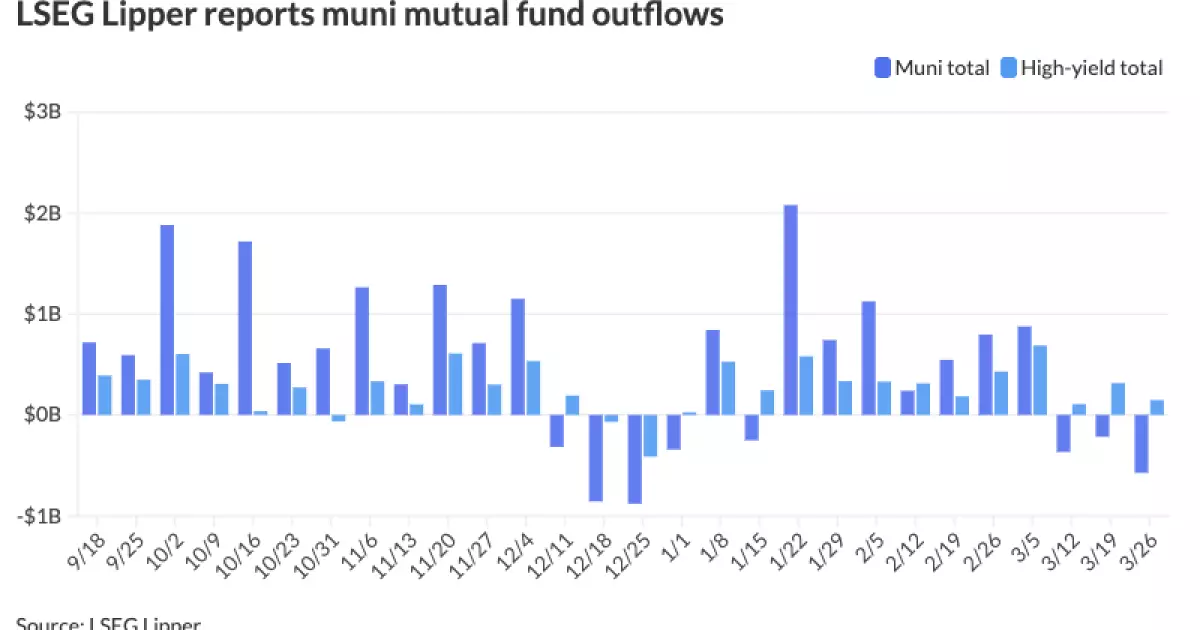The current state of the municipal bond market raises considerable alarms for investors. As yields continue to rise, it is important to understand that these changes are not merely fluctuations but indicative of deeper systemic issues. Traditionally viewed as one of the safer investments, municipal bonds are experiencing a crisis of confidence this March, marked by significant supply challenges and investor outflows. Fundamentally, the economic principles that once underpinned this market are now facing increasing pressures, making it vital for investors to be cautious.
The Rise of Yields: A Tumultuous Month
March has seen an unprecedented increase in rates, largely attributed to weak overarching economic indicators and rising inflationary pressures. Municipal yield ratios have climbed—showing concerning shifts such as a two-year municipal to U.S. Treasury (UST) ratio standing at 69%. The consistent uptrend of yields, as articulated by portfolio managers, illustrates a market adjusting to a new “normal.” The message is clear: this is no longer the accommodating environment of previous months, where low yields inspired more significant investments and paved the way for a stable market.
In fact, bond funds registered substantial outflows, alongside a troubling shift in investor sentiment. Recent data shows $573.3 million was withdrawn from municipal bond mutual funds, continuing a potential downward trend over several weeks. Investors should be questioning not just where they are putting their money, but the very fundamentals of what comprised the protected landscape of municipal bonds.
Headwinds: More Than Just an Investor’s Nightmare
Economic pressures have been compounded by several external challenges. When financial structures are crumbling under the weight of leverage, questions arise regarding their sustainability. The high levels of dealer inventories indicate a market struggling with distribution, and the reality is that this carries inherent risks for both municipalities and investors alike. This month, the inventory reached a staggering $15.4 billion—an all-time high. Such supply challenges could mean distressed selling, ultimately indicative of a shaken investor confidence circling back to the fundamental financial health of municipal issuers.
Additionally, the persistent speculation surrounding economic recovery and growth estimates has added a layer of uncertainty to the market landscape. Are capex and operational expenditures aligned with the rising rates? Rising yields spell trouble, especially when projected income doesn’t seem to keep pace. Therefore, it is incumbent upon investors to examine balances more rigorously than before.
New Opportunities or Just a Martyrdom for Risk?
While there may be glimmers of opportunity for discerning investors, the allure of low buy-in costs should not overshadow the risk of potential capital losses. A notable shift has occurred with AAA ratings now 60 basis points higher than six months ago. Investors might be tempted by attractions like the high-grade bonds with intricate call structures offering higher yields—but one must tread carefully. Opportunities in yields exceeding 4% may appear attractive, yet the undercurrents of risk remain.
The reaction to this situation is divided; while some perceive value in the face of adversity, others argue that we are approaching a reckoning. The prices of bonds due in 20 years and longer are experiencing shifts above 4.00%, contributing to an increasingly speculative environment. Indeed, premium coupon buyers are stepping up only to find that yields are materially higher compared to just months ago. Thus, the landscape has morphed from a bastion of stability to a field marked by volatility and unpredictability.
Why Caution Is the New Order
The consensus of financial observers is clear: the municipal bond market may not be the safe haven it once was. The recent performance has brought to light issues that had been somewhat obscured—and investors cannot afford to ignore these warnings. As state and local governments grapple with their financial futures amid broader economic malaise, the only strategic option is extreme caution.
Many investors may have a historical tendency to overvalue equities and undervalue bonds, but the heuristic fails in today’s environment. Rising interest rates mean it’s not just about perceived security; it’s about ensuring the sustainability and responsible management of funds. Thus, a careful analysis of credit risks and broader economic factors must replace naïve optimism.
The landscape forecast for municipal bonds looks dire. With rising yields and compounding economic pressures marking a shift, the traditional reassurances investors once felt are now fraught with uncertainty. In such an environment, it would be wise to approach this market with renewed skepticism rather than blind allegiance.

